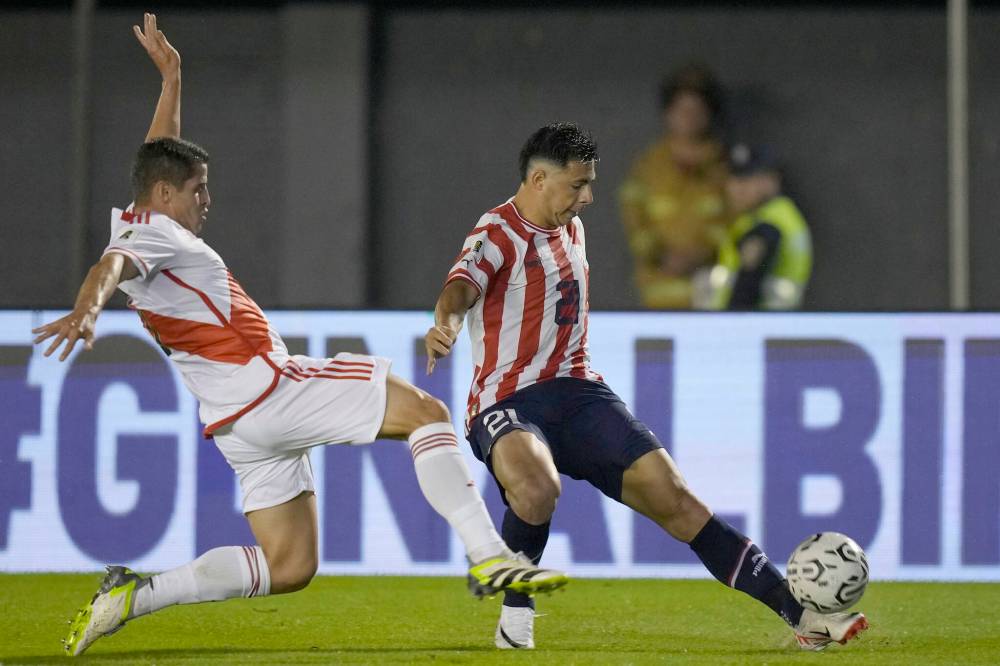2026 World Cup closer than you think
Qualifying underway for what promises to be biggest sporting event ever
Advertisement
Read this article for free:
or
Already have an account? Log in here »
To continue reading, please subscribe:
Monthly Digital Subscription
$0 for the first 4 weeks*
- Enjoy unlimited reading on winnipegfreepress.com
- Read the E-Edition, our digital replica newspaper
- Access News Break, our award-winning app
- Play interactive puzzles
*No charge for 4 weeks then price increases to the regular rate of $19.95 plus GST every four weeks. Offer available to new and qualified returning subscribers only. Cancel any time.
Monthly Digital Subscription
$4.99/week*
- Enjoy unlimited reading on winnipegfreepress.com
- Read the E-Edition, our digital replica newspaper
- Access News Break, our award-winning app
- Play interactive puzzles
*Billed as $19.95 plus GST every four weeks. Cancel any time.
To continue reading, please subscribe:
Add Free Press access to your Brandon Sun subscription for only an additional
$1 for the first 4 weeks*
*Your next subscription payment will increase by $1.00 and you will be charged $16.99 plus GST for four weeks. After four weeks, your payment will increase to $23.99 plus GST every four weeks.
Read unlimited articles for free today:
or
Already have an account? Log in here »
Hey there, time traveller!
This article was published 08/09/2023 (855 days ago), so information in it may no longer be current.
The 2026 FIFA men’s World Cup will be the biggest sporting event in history. And the longest. In fact, it’s already begun.
Earlier this week, less than nine months after Lionel Messi lifted the trophy in Doha, qualification for the tournament co-hosted by Canada, Mexico and the United States kicked off in southeast Paraguay. The hosts played Peru to a scoreless draw at Estadio Antonio Aranda, about 7,000 km. from Mexico City’s Estadio Azteca, the likely venue of the World Cup proper’s opening match just over 32 months from now.
Later Thursday evening, Colombia forward Santos Borre scored the first goal in a journey that, by the spring of 2026, will have already involved 208 national teams and almost 1,000 games. Argentina were in action, too, and with nine of the 11 players that took the field against France in December beat Ecuador 1-0 in Buenos Aires.

Jorge Saenz / The Associated Press
Qualifying for the 2026 World Cup kicked off Thursday with Peru visiting Paraguay.
So the route to the next World Cup is already being travelled, though, incredibly, no one knows exactly where it will finish.
MetLife Stadium, home to the New York Giants and Jets, was considered the early favourite to stage the Final, but the Dallas Cowboys’ AT&T Stadium, with its retractable roof, might have the current momentum. Inglewood’s SoFi Stadium would perhaps be the most glamorous option, but the surface is narrow and any expansion would eat into capacity.
All that’s certain is the game will be played July 19, in the United States, in one of three time zones.
Practically speaking, there’s really no need to determine a venue just yet. That said, FIFA has already been guilty of making it up as it goes along, what with on-the-fly adjustments made to the number and composition of groups, nevermind president Gianni Infantino’s bizarre previous musings that the competition could be held every two or three years instead of four.
For all the excitement that accompanies a World Cup on this continent, it remains very much an event of the unknown. There are at least three overarching categories of questions and concerns that have either yet to be answered or simply won’t be addressed until the record 48 teams have arrived on these shores.
Inevitably, one of them involves logistics-specific issues, such as the location of the Final. Neither is the inaugural match a fait accompli, although the Azteca is widely expected to host both it and the opening ceremonies. The Mexican team would obviously be involved in the curtain-raiser, and the United States will open its schedule on home soil as well.
But what of Canada? This country’s venues in Toronto and Vancouver will be splitting group stage brackets with counterparts in Boston, Philadelphia, Seattle or San Francisco. Will the Canadian team have an actual home opener as well? You could almost see them being the half-forgotten littlest sibling. Thankfully, these sorts of issues can be easily dealt with at organizational level.
Less so the social issues.
The Qatar World Cup was contested under a dual spotlight of world-class football and sharp, sustained criticism. There’s no reason to think the follow-up tournament will be any different, and thankfully so. High-profile global gatherings necessarily draw attention to the ills affecting their hosts, and any number of matters will be protested in 2026.
If it wasn’t already, the world will be made increasingly aware of Canada’s historic and ongoing mistreatment of Indigenous peoples. Mexico’s lesser-known raft of enforced disappearances, highlighted by a recent UN report, will no longer be able to fly under the radar. Ditto its suppression of journalists.
Then there’s the United States.
Given the matches in Miami, demonstrations will loudly decry Florida’s anti-LGBTTQ+ laws and outright racist education curricula. Games in Dallas, Houston and Kansas City will highlight the ongoing eradication of women’s rights throughout the country. The matter of guns will be ever present. All told, the global mood and sheer scope of the World Cup will likely combine to make its American component the most widely-protested event in the history of sports.
Finally, there’s the issue of the actual football.
As qualifying continues, a cluster of contenders will emerge from the pack. Will Argentina remain among them? And will Messi still be playing internationally in 2026? With 48 teams, the roster has increased by 16. But will a traditional heavyweight fail to make the cut?
As co-hosts, Canada don’t need to go through qualification, which means they’ll be relying on CONCACAF tournaments and friendly matches for preparation. Yet, they’re not even active in the ongoing international period and will play just once in October. Was former manager John Herdman right in suggesting this country isn’t “serious” about 2026?
Conversely, which Canadian players could reach new, impressive heights in the next two-and-a-half years? More globally, the era of Messi and Cristiano Ronaldo has already given way to that of Erling Haaland, Vinicius Junior, Kylian Mbappe, Victor Osimhen and Jude Bellingham. Will the up-and-coming collection of superstars deliver the unforgettable World Cup that everyone’s expecting?
If it seems as though we’ve only just come out of a World Cup cycle, it’s because we have. And if it seems as though the next competition has suddenly crept up on us, it’s because it did. Essentially, it’s already begun.
Nevertheless, there’s a whole lot still to be sorted between this week’s Paraguay-Peru showdown and the group stage draw just over two years from now. While the co-hosts aren’t even thinking about how a sport will impact global perceptions, they suddenly will – and soon.
The 2026 World Cup is no longer a far-off thing. It’s already here, now, being vied for, its story already being told. While there’s a lot to prepare, to consider, there’s much to start getting excited about, too.
jerradpeters@gmail.com
X @JerradPeters
Our newsroom depends on a growing audience of readers to power our journalism. If you are not a paid reader, please consider becoming a subscriber.
Our newsroom depends on its audience of readers to power our journalism. Thank you for your support.







